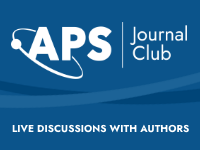| Volume 108, Issue 4 October 2023 | |
Advertisement  | Do you need language assistance for your next submission? Take advantage of new translation, figure assistance, and text editing services provided by APS and Editage. Experience exceptional support, expertise, and dedication for all your publishing needs. Get a quote. | | | | | | | Not an APS member? Join today to start connecting with a community of more than 50,000 physicists. | | | | Editors' Suggestion Pierre Lassègues, Mateus Antônio Fernandes Biscassi, Martial Morisse, André Cidrim, Pablo Gabriel Santos Dias, Hodei Eneriz, Raul Celistrino Teixeira, Robin Kaiser, Romain Bachelard, and Mathilde Hugbart Phys. Rev. A 108, 042214 (2023) – Published 18 October 2023  | The authors study the loss of light coherence when scattered by a macroscopic atomic cloud of cold neutral atoms through intensity-intensity correlation measurements. They demonstrate experimentally and theoretically the transition between classical and quantum mechanisms regimes for the coherence loss. | | | | | | Editors' Suggestion Shikha Bangar, Leanto Sunny, Kübra Yeter-Aydeniz, and George Siopsis Phys. Rev. A 108, 042414 (2023) – Published 16 October 2023  | The authors propose a continuous-variable quantum-classical neural network protocol that could be potentially realized in current photonic experiments. Their protocol only uses Gaussian operations, and a nonlinear operation is obtained through repeat-until-success measurements on ancillary qumodes. They applied their method to simulate quantum machine learning and computing problems. | | | | | | Editors' Suggestion Francisco Riberi, Gerardo A. Paz-Silva, and Lorenza Viola Phys. Rev. A 108, 042419 (2023) – Published 19 October 2023  | The authors consider frequency estimation in the presence of spatiotemporally correlated noise. They show that the usual approach involving unbiased estimators is ill-suited in such cases, and introduce new estimators which, at the cost of doubling the required resources, are insensitive to noise and retain the precision scaling of standard ones. | | | | | | Editors' Suggestion Federico Centrone, Frederic Grosshans, and Valentina Parigi Phys. Rev. A 108, 042615 (2023) – Published 20 October 2023  | The authors give insight into the amount of entanglement that can be achieved from Gaussian graph states as well as the amount of squeezing required to prepare them. They find that these quantities are highly dependent on the structure of the quantum network. | | | | | | Editors' Suggestion Chris H. Greene and Matthew T. Eiles Phys. Rev. A 108, 042805 (2023) – Published 11 October 2023  | The authors present a method based on the Coulomb Green's function to derive the electronic structure of ultra-long-range Rydberg molecules including spins, providing a promising alternative to the standard method based on basis-set expansion, which was shown to have serious convergence problems. Use of this approach should enable more accurate studies of Rydberg-molecule spectra and the electron-atom scattering phase shifts upon which they depend. | | | | | | Editors' Suggestion O. N. Prudnikov, R. Ya. Ilenkov, A. V. Taichenachev, V. I. Yudin, and S. N. Bagaev Phys. Rev. A 108, 043107 (2023) – Published 9 October 2023  | It is possible to trap neutral atoms in optical lattices without using magnetic fields, but it is currently difficult to achieve deep trapping potentials in such systems. Here, the authors propose using bichromatic light to induce an optical rectification effect that results in a strong spatial force variance and therefore deep dissipative potentials, demonstrating that such lattices could replace magneto-optical traps in neutral atom cooling and trapping applications. | | | | | | Editors' Suggestion Sebastian Franke, Juanjuan Ren, and Stephen Hughes Phys. Rev. A 108, 043502 (2023) – Published 4 October 2023  | The authors develop a regularized quasinormal-mode perturbation theory for quasinormal modes of leaky resonators, which can be used to predict the impact of weak perturbations placed outside the resonators of interest. The general method is then applied to two illustrative examples, a one-dimensional double-barrier system and a three-dimensional plasmonic dimer structure. | | | | | | Editors' Suggestion Gaëtan Lévêque, Yan Pennec, Pascal Szriftgiser, Alberto Amo, and Alejandro Martínez Phys. Rev. A 108, 043505 (2023) – Published 10 October 2023  | The authors explore limitations to topological protection in valley Hall waveguides by developing a phenomenological semi-analytical model for analyzing different sources of backscattering. The model can be used to predict the performance of larger-scale structures that are intractable using direct finite-element simulations. | | | | | | | |


No comments:
Post a Comment